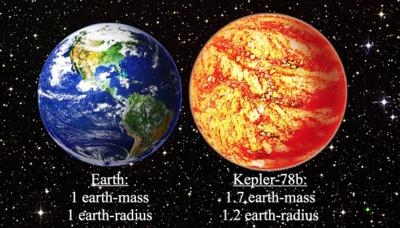Sun, Nov 03, 2013
But Kepler-78b Is A 'Blazing Inferno'
Astronomers have discovered the first Earth-sized planet outside the solar system that has a rocky composition like that of Earth. Kepler-78b whizzes around its host star every 8.5 hours, making it a blazing inferno and not suitable for life as we know it. The results are published in two papers in the journal Nature.

"The news arrived in grand style with the message: 'Kepler-10b has a baby brother,'" said Natalie Batalha, Kepler mission scientist at NASA's Ames Research Center in Moffett Field, CA. Batalha led the team that discovered Kepler-10b, a larger but also rocky planet identified by the Kepler spacecraft
"The message expresses the joy of knowing that Kepler's family of exoplanets is growing," Batalha reflects. "It also speaks of progress. The Doppler teams are attaining higher precision, measuring masses of smaller planets at each turn. This bodes well for the broader goal of one day finding evidence of life beyond Earth."
Kepler-78b was discovered using data from NASA’s Kepler space telescope, which for four years simultaneously and continuously monitored more than 150,000 stars looking for telltale dips in their brightness caused by crossing, or transiting, planets. Two independent research teams then used ground-based telescopes to confirm and characterize Kepler-78b. To determine the planet's mass, the teams employed the radial velocity method to measure how much the gravitation tug of an orbiting planet causes its star to wobble. Kepler, on the other hand, determines the size or radius of a planet by the amount of starlight blocked when it passes in front of its host star.
A handful of planets the size or mass of Earth have been discovered. Kepler-78b is the first to have both a measured mass and size. With both quantities known, scientists can calculate a density and determine what the planet is made of.
Kepler-78b is 1.2 times the size of Earth and 1.7 times more massive, resulting in a density that is the same as Earth's. This suggests that Kepler-78b is also made primarily of rock and iron. Its star is slightly smaller and less massive than the sun and is located about 400 light-years from Earth in the constellation Cygnus.
(Image provided by NASA)
More News
Check out https://affordableflying.net/attend/ Right Away and Get YOUR Tickets To the Affordable Flying Expo! OK.... with a little over a month to go, it’s time to get seriou>[...]
"Amelia made it almost three-quarters of the way around the world before she suddenly, and without notice, vanished—never to be seen again. Her disappearance, almost 90 years>[...]
Aero Linx: Cessna 150-152 Club The Cessna 150-152 Club has been the go-to place for information about the care and operation of the World’s Most Popular Two-Place Airplane si>[...]
Hover Taxi Used to describe a helicopter/VTOL aircraft movement conducted above the surface and in ground effect at airspeeds less than approximately 20 knots. The actual height ma>[...]
Also: Purdue In Space?, 4 SpecOps Lost In Helo Crash, Solid-Fuel Ramjet, Ultra-High Airspace Over FL The US Army recently confirmed its plans to thin out its active duty aviation r>[...]
 Ticket Sales NOW OPEN for 2025 Affordable Flying Expo!
Ticket Sales NOW OPEN for 2025 Affordable Flying Expo! Aero-News: Quote of the Day (09.29.25)
Aero-News: Quote of the Day (09.29.25) ANN's Daily Aero-Linx (09.29.25)
ANN's Daily Aero-Linx (09.29.25) ANN's Daily Aero-Term (09.29.25): Hover Taxi
ANN's Daily Aero-Term (09.29.25): Hover Taxi Airborne 09.26.25: Army Cuts AV-Ranks, 2025 ATC Hiring, AF Next-Gen Fighter
Airborne 09.26.25: Army Cuts AV-Ranks, 2025 ATC Hiring, AF Next-Gen Fighter



